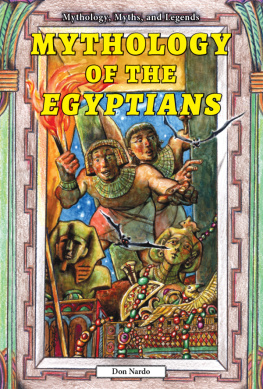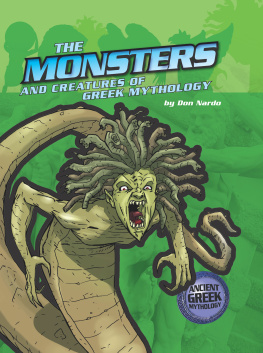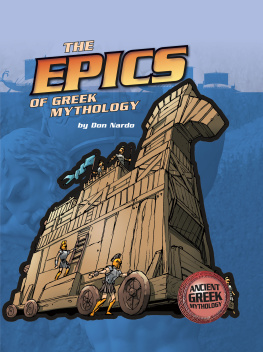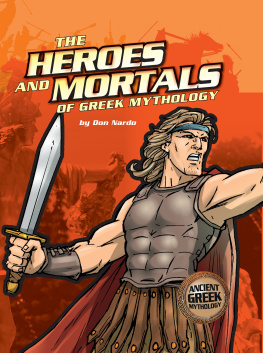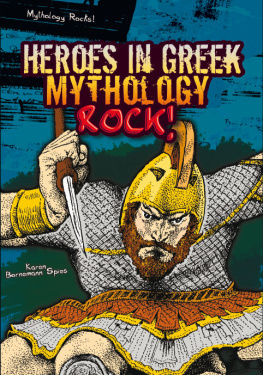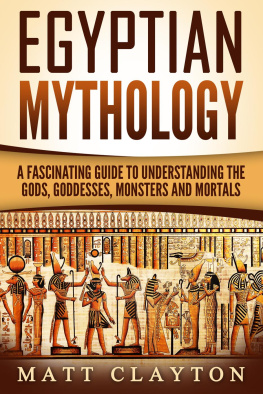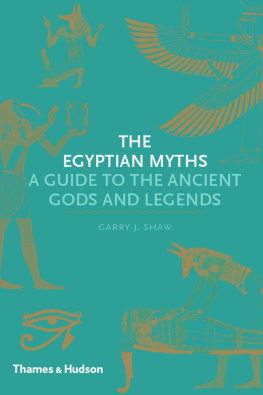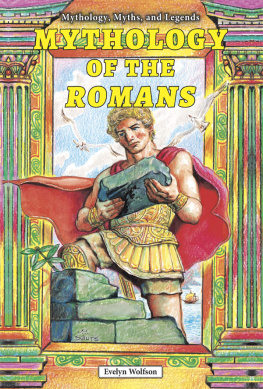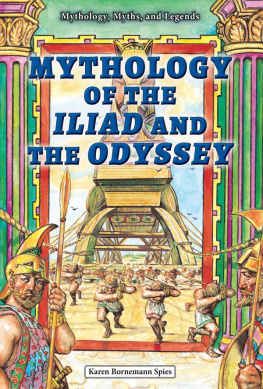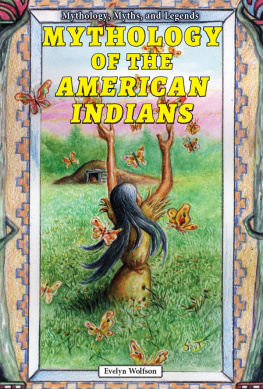The Unique Culture of the Egyptians
The ancient Egyptians told many of the myths in this book as many as six thousand years ago, when their civilization flourished in the Nile River valley. Some stories were written down on papyrus or inscribed in stone. All of them reflect the unique culture of the Egyptians, including the physical characteristics of their country and the customs dictating their modes of worship.
From the creation of Egypts gods and goddesses to the adventures of pharaohs and everyday citizens, in Mythology of the Egyptians author Don Nardo reveals the rich history and traditions of the region. Each story is enhanced by the expert commentary of noted scholars and mythology specialists.
...fascinating mythsabout Isis, Horus, Ra, and others...
Booklist
...clear, readable text.
School Library Journal
About the Author
Historian Don Nardo has published many books about the ancient world, including studies of the Egyptian pyramids, the Greek Parthenon, and the Roman Colosseum.
About the Illustrator
William Sauts Bock has illustrated many books, and his illustrations was honored by the American Institute of Graphic Arts.

The nature of the gods in Egyptian mythology, along with their deeds and the customs surrounding their worship, strongly reflected the physical characteristics of the country and its unique culture. Other characters in Egypts myths also reflect the local heritage.
Egypt is a land of marked physical extremes. Situated in the northeastern sector of Africa, the country consists primarily of dry desert wastelands stretching for hundreds of miles in all directions. Almost all of the ancient Egyptians lived in a narrow, very fertile strip of land bordering the Nile River. From the highlands of Ethiopia in the south, the Nile flows to the Mediterranean Sea in the north. It was in this pleasant and productive Nile valley, irrigated by the river, that the ancient Egyptians built the worlds first great civilization.
The beginnings of that civilization, which lasted for many thousands of years, are lost in the mists of time. But historians know that as early as 4500 B.C. (about 6,500 years ago), Egypt consisted of two separate regions, each with a relatively advanced culture in which people lived together in villages, farmed the land, and raised livestock. Slowly, these two separate regions grew into kingdoms ruled by monarchs. One of the kingdoms, Upper Egypt, stretched from Aswan, in the far south, northward to the city of Memphis. The other, Lower Egypt, was composed of the lands north of Memphis, including the fan-shaped, very fertile Nile delta, where the river empties into the Mediterranean Sea. (The Egyptians based their conception of Upper and Lower regions on the direction in which the Nile flows. To them, the rivers source seemed up, or north, and its end pointed down, or south, whereas on a modern map the Nile flows from south to north.)
These two kingdoms finally became united into one country sometime between 3150 and 3100 B.C. by Menes, a powerful king of Upper Egypt. He took the title of pharaoh and established his capital at Memphis. Thereafter, all of Egypts rulers were called pharaohs. Menes also founded the first dynasty (a succession of rulers, all of whom belonged to the same family) in Egypt.
In the two thousand years following Meness unification of Egypt, the country attained its greatest level of power, influence, and cultural achievement. For convenience, modern historians divide this long period into several shorter ones. The period encompassing the First and Second Dynasties, in which sixteen pharaohs reigned, is referred to both as the Early Dynastic Period and the Archaic Period (around 31002690 B.C.). Next came the period called the Old Kingdom (around 26902180 B.C.), in which most of the great pyramids were erected; then a short intermediate period; then the Middle Kingdom (around 20551650 B.C.), in which trade with other peoples greatly expanded and Egypt absorbed much of Nubia, a region lying to its south; then another short intermediate period; and finally the New Kingdom (around 15501070 B.C.), in which a series of powerful pharaohs conquered other parts of the Near East, creating a great Egyptian empire.
Following the end of the New Kingdom, Egypt entered a long period of decline under mostly weak rulers, followed by Persians, Greeks, and other foreigners who had seized the throne. Eventually, in 31 B.C., the Romans, who had by then built a huge and powerful Mediterranean empire, defeated Egypts last independent rulerthe famous Cleopatra VII (who was actually Greek). In the thirty centuries from Menes to Cleopatra, more than two hundred pharaohs, belonging to some thirty dynasties, had ruled the country.
During these three thousand years, the everyday life of the average Egyptian remained essentially unchanged. Most people were farmers. They were almost completely dependent on the Nile because rainfall was very scarce, and they needed its waters for drinking, cooking, bathing, washing clothes, and irrigating crops. Using barges and boats, they also traveled on the river from city to city.
In addition, the people of Egypt used the Nile to mark the passage of time and the seasons. For example, from June to September, the season they called akhet, the Nile flooded, gently covering the fields along its banks with several feet of water and laying down a fresh layer of rich soil. It was not possible to farm the land during this flood season. Many people took the opportunity to rest. Others kept themselves busy making pottery, jewelry, and other handicrafts. Still others worked on government-sponsored projects, including the building of pyramids, temples, and other large stone structures.
Nearly all Egyptians returned to the fields during the other seasons, although a few practiced crafts and trades, such as carpentry and metal-working, year-round. At planting time, in the season of peret (lasting from October to February), farmers plowed their fields and planted the seeds of many crops. These included barley, emmer (a kind of wheat), flax (used to make linen cloth), papyrus reeds (used to make paper), and various fruits and vegetables. In the dry season, called shemu (lasting from February to June), the farmers harvested these crops. They also raised cattle, goats, sheep, pigs, and other livestock.
A small number of Egyptians were not directly involved in growing food, raising livestock, or the various crafts and trades. Usually, these were wealthier and more socially prominent individuals who ruled over the poorer masses. As noted scholar Lionel Casson explains:
Egypts social structure formed a pyramid almost as neat as those built for her kings. It stood foursquare on the broad base of the mass of peasants who cultivated the rich land. Above them rose a series of narrowing layers: the mayors of the villages and their staffs, the governors of the various districts into which the country was divided for administrative purposes and their staffs, the ministers of state and other lofty officials at the capital,and, capstone of the whole, the pharaoh.
The Egyptians looked on the pharaoh as a living god, and he resided, along with his many wives, children, advisors, and noble followers, in great splendor in a large and magnificent palace. There, these elite persons were attended by hundreds of royal servants. Among them were physicians, scribes (who wrote letters and kept records), guards, maids, cooks, bakers, weavers, sculptors, chariot-drivers, and stable-keepers. By contrast, most Egyptian peasants lived in simple huts made of sun-dried bricks. Such humble dwellings typically had one or two small rooms with dirt floors and sometimes housed the owners animals as well as members of his family.

